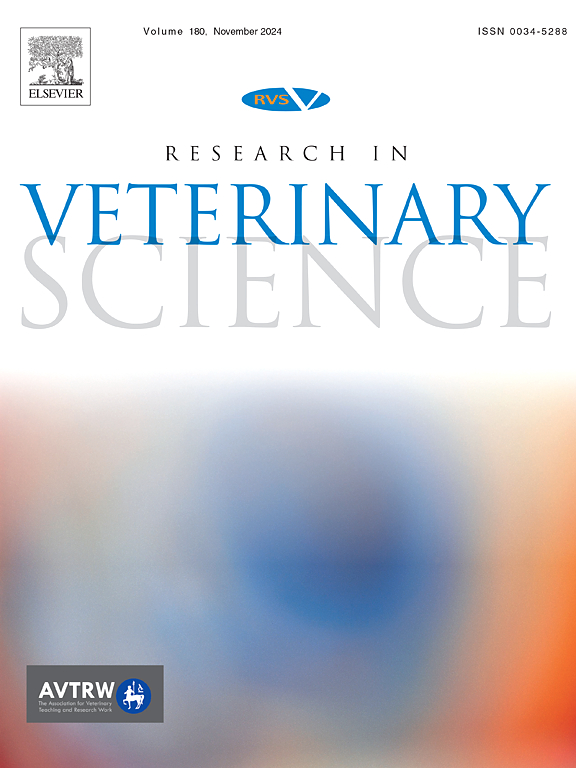Dietary prebiotic alleviates experimentally induced coccidiosis in broilers
IF 2.2
3区 农林科学
Q1 VETERINARY SCIENCES
引用次数: 0
Abstract
An experiment was conducted to determine the effects of prebiotic on growth performance and coccidiosis prevention in challenged broilers with Eimeria. A total of 420 1-d-old male Ross 308 chicks were used in a completely randomized design with 7 treatments and 5 replicates with 12 birds in each replication. Dietary treatments were: 1) negative control (without prebiotic and without challenge), 2) positive control (challenged with sporulated oocysts of Eimeria (SOE) without prebiotic), 3) 0.2 % prebiotic in starter, 0.1 % in grower and 0.05 % in finisher challenged with SOE, 4) 0.2 % prebiotic in starter,0.1 % in grower and 0.05 % in finisher without challenge, 5) 0.2 % prebiotic in the whole rearing period challenged with SOE, 6) 0.2 % prebiotic in the whole rearing period without challenge and 7) and Salinomycin (0.05 % of diet). At 7 d of age, treatments were challenged with 20-fold dose of the EIMERIAVAX 4 m as a trivalent live attenuated coccidiosis vaccine. On d 28, intestinal coccidiosis lesions and dropping were scored in the scale of 0–3 and 0–4, respectively, and oocysts per gram feces (OPG) were measured. Prebiotic at either supplementation rate increased body weight gain and improved feed conversion ratio compared with PC group. Challenged broilers fed fixed level of prebiotic displayed lower OPG, dropping scores and coccidiosis lesions scores in upper and middle regions of intestine than PC group, with the effect being similar to unchallenged birds.
膳食益生素可减轻实验性肉鸡球虫病。
我们进行了一项实验,以确定益生素对受到艾美耳病挑战的肉鸡的生长性能和球虫病预防的影响。实验采用完全随机设计,共使用了 420 只 1 日龄雄性罗斯 308 雏鸡,7 个处理,5 个重复,每个重复 12 只鸡。日粮处理包括1)阴性对照(无益生素且无挑战);2)阳性对照(用艾美拉氏杆菌孢子化卵囊(SOE)进行挑战,无益生素);3)用 0.2 % 的益生素进行初生雏鸡、0.1 % 的益生素进行生长雏鸡和 0.05 % 的益生素进行育成雏鸡的挑战;4)用 0.2 % 的益生素进行初生雏鸡、0.1 % 的益生素进行生长雏鸡和 0.05 % 的益生素进行育成雏鸡的挑战。5)在整个饲养期间添加 0.2 % 的益生素,并添加 SOE;6)在整个饲养期间添加 0.2 % 的益生素,但不添加 SOE;7)添加盐霉素(日粮的 0.05 %)。7 日龄时,用 20 倍剂量的 EIMERIAVAX 4 m 作为三价球虫减毒活疫苗进行免疫接种。第 28 d,分别按 0-3 和 0-4 级对肠道球虫病变和下降进行评分,并测量每克粪便中的卵囊数(OPG)。与 PC 组相比,任一添加量的益生元都能提高增重和饲料转化率。与 PC 组相比,添加固定剂量益生元的挑战肉鸡的 OPG、下降评分和肠道中上部的球虫病变评分均低于 PC 组,其效果与未添加益生元的肉鸡相似。
本文章由计算机程序翻译,如有差异,请以英文原文为准。
求助全文
约1分钟内获得全文
求助全文
来源期刊

Research in veterinary science
农林科学-兽医学
CiteScore
4.40
自引率
4.20%
发文量
312
审稿时长
75 days
期刊介绍:
Research in Veterinary Science is an International multi-disciplinary journal publishing original articles, reviews and short communications of a high scientific and ethical standard in all aspects of veterinary and biomedical research.
The primary aim of the journal is to inform veterinary and biomedical scientists of significant advances in veterinary and related research through prompt publication and dissemination. Secondly, the journal aims to provide a general multi-disciplinary forum for discussion and debate of news and issues concerning veterinary science. Thirdly, to promote the dissemination of knowledge to a broader range of professions, globally.
High quality papers on all species of animals are considered, particularly those considered to be of high scientific importance and originality, and with interdisciplinary interest. The journal encourages papers providing results that have clear implications for understanding disease pathogenesis and for the development of control measures or treatments, as well as those dealing with a comparative biomedical approach, which represents a substantial improvement to animal and human health.
Studies without a robust scientific hypothesis or that are preliminary, or of weak originality, as well as negative results, are not appropriate for the journal. Furthermore, observational approaches, case studies or field reports lacking an advancement in general knowledge do not fall within the scope of the journal.
 求助内容:
求助内容: 应助结果提醒方式:
应助结果提醒方式:


